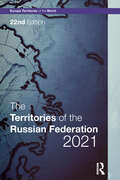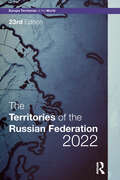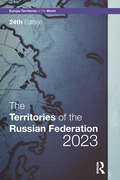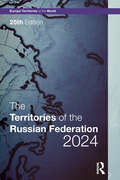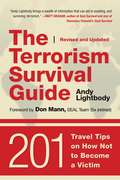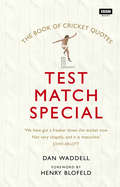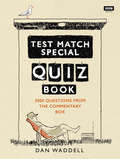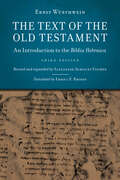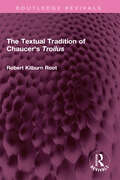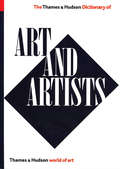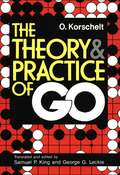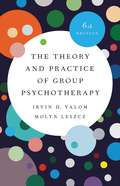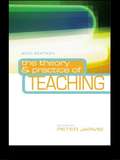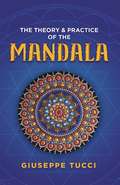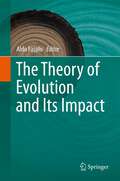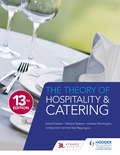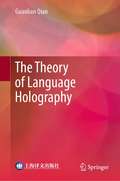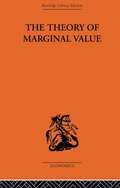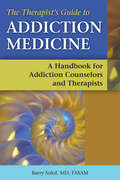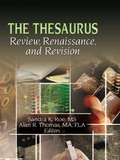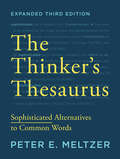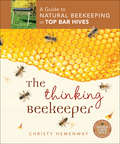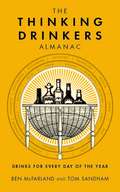- Table View
- List View
The Territories of the Russian Federation 2021
by Dominic HeaneyThis excellent reference source brings together hard-to-find information on the constituent units of the Russian Federation. The introduction examines the Russian Federation as a whole, followed by a chronology, demographic and economic statistics, and a review of the Federal Government. The second section comprises territorial surveys, each of which includes a current map. This edition includes surveys covering the annexed (and disputed) territories of Crimea and Sevastopol, as well as updated surveys of each of the other 83 federal subjects. The third section comprises a select bibliography of books. The fourth section features a series of indexes, listing the territories alphabetically, by Federal Okrug and Economic Area. Users will also find a gazetteer of selected alternative and historic names, a list of the territories abolished, created or reconstituted in the post-Soviet period, and an index of more than 100 principal cities, detailing the territory in which each is located.
The Territories of the Russian Federation 2022
by Dominic HeaneyThis excellent reference source brings together hard-to-find information on the constituent units of the Russian Federation. The introduction examines the Russian Federation as a whole, followed by a chronology, demographic and economic statistics, and a review of the Federal Government. The second section comprises territorial surveys, each of which includes a current map. This edition includes surveys covering the annexed (and disputed) territories of Crimea and Sevastopol, as well as updated surveys of each of the other 83 federal subjects. The third section comprises a select bibliography of books. The fourth section features a series of indexes, listing the territories alphabetically, by Federal Okrug and Economic Area. Users will also find a gazetteer of selected alternative and historic names, a list of the territories abolished, created or reconstituted in the post-Soviet period, and an index of more than 100 principal cities, detailing the territory in which each is located.
The Territories of the Russian Federation 2023 (Europa Territories Of The World Ser.)
by Dominic HeaneyThis excellent reference source brings together hard-to-find information on the constituent units of the Russian Federation. The introduction examines the Russian Federation as a whole, followed by a chronology, demographic and economic statistics, and a review of the Federal Government. The second section comprises territorial surveys, each of which includes a current map. This edition includes surveys covering the annexed (and disputed) territories of Crimea and Sevastopol, as well as updated surveys of each of the other 83 federal subjects. The third section comprises a select bibliography of books. The fourth section features a series of indexes, listing the territories alphabetically, by Federal Okrug and Economic Area. Users will also find a gazetteer of selected alternative and historic names, a list of the territories abolished, created or reconstituted in the post-Soviet period, and an index of more than 100 principal cities, detailing the territory in which each is located.
The Territories of the Russian Federation 2024 (Europa Territories of the World series)
This excellent reference source brings together hard-to-find information on the constituent units of the Russian Federation.The introduction examines the Russian Federation as a whole, followed by a chronology, demographic and economic statistics, and a review of the Federal Government. The second section comprises territorial surveys, each of which includes a current map. This edition includes surveys covering the annexed (and disputed) territories of Crimea and Sevastopol, as well as updated surveys of each of the other 83 federal subjects. The third section comprises a select bibliography of books. The fourth section features a series of indexes, listing the territories alphabetically, by Federal Okrug and Economic Area. Users will also find a gazetteer of selected alternative and historic names, a list of the territories abolished, created or reconstituted in the post-Soviet period, and an index of more than 100 principal cities, detailing the territory in which each is located.
The Terrorism Survival Guide: 201 Travel Tips on How Not to Become a Victim, Revised and Updated
by Andy LightbodyThe age of carefree travel is over. The threats of criminal acts and of terrorism, both internationally and domestically, are an all-too-common reality. Last year saw more than fourteen thousand terrorist incidents across the globe—it’s no wonder that people are frightened when they are away from home.The Terrorism Survival Guide: 201 Travel Tips on How Not to Become a Victim can help take away that fear. The book is an easy-to read pocket guide with hundreds of tips that help take away the worry of business and vacation travels. These tips are designed for everyone and cover a wide range of topics:Staying safe at airportsHow to protect your luggage“Low profile” tourismTraveling with childrenWhat to do if capturedIn addition to travel tips, the book gives contact information for US embassies and consulates worldwide, US Customs information, State Department terrorism updates, and TSA guidelines. The Terrorism Survival Guide will make you a wiser, smarter, and safer traveler.
The Test Match Special Book of Cricket Quotes
by Dan WaddellCollecting hundreds of quips and quotes, and beautifully illustrated throughout, The Test Match Special Book of Cricket Quotes is a cricket fan’s indispensable guide to bats, beards, boundaries and bowls.From witty sayings and wise words, to doubles entendres, and legendary moments from cricketing history, you’ll find the perfect line for every occasion.‘I've never got to the bottom of streaking’- Jonathan Agnew‘On the first day Logie decided to chance his arm and it came off' - Trevor Bailey‘Bill Frindall has done a bit of mental arithmetic with a calculator’- John Arlott'Strangely, in slow motion, the ball seemed to hang in the air for even longer' - David Acfield'I'm not into caps with lots of diamonds on them, like KP' - James Anderson'How can you tell your wife you are just popping out to play a match and then not come back for five days?' - Rafa Benitez on test cricket ‘I don't think we choked this time. We never played well enough to choke’ - Craig Matthews‘Flintoff starts in, his shadow beside him. Where else would it be?’- Henry Blofeld‘I once delivered a simple ball, which I was told, had it gone far enough, would have been considered a wide’ - Lewis Carroll
The Test Match Special Quiz Book
by Dan WaddellFor over 50 years, Test Match Special has provided listeners with every Test cricket ball, batting average, and plenty of views from the boundary, too. But how well do you know your cricket? Pit your wits against Aggers, Tuffers, Boycs and Johnners – and try not to get caught out! Can you identify the most famous players from history, name that ground or reel off well-known (and lesser-known) stats and facts. And of course, what Test Match Special would be complete without the gaffes, giggles, cakes and celebrity guests who make up a day at the cricket? With over 3,000 mind-bending puzzles about every aspect of the sport and beyond, this is the ultimate test of any cricket fan's true average.
The Text of the Old Testament: An Introduction to the Biblia Hebraica
by Ernst Wurthwein Alexander Achilles FischerKristin De Troyer — University of St. Andrews &“This finely revised and nicely updated version of one of the classics in our field can truly be called a grand introduction to the history of the biblical text.&”Leonard Greenspoon — Creighton University &“Readers familiar with Würthwein&’s earlier work will discover all of the strengths of his approach to Biblical Hebrew. Old and new readers will enjoy the thoroughly up-to-date discussion of the aims and methods of textual criticism as well as the unbiased analysis of ancient versions and their modern scholarly editions. Beautifully reproduced plates are easy to read, and the updated bibliography is satisfyingly full. . . . This successful project can be easily digested by newcomers and savored by specialists.&”Robert L. Hubbard — North Park Theological Seminary &“A very welcome, thorough revision of the long-honored standard introduction to the Masoretic text. Its integration of recent scholarship is first-rate, and the rewritten text retains the clear, accessible style that won its predecessors decades of popularity as a textbook. Yet another generation of students will find in this book a friendly, reliable guide through the complex terrain of ancient Hebrew texts and their relationships. Highly commended.&”The Bible Today &“Every scholar and serious Bible student should have a passing knowledge of the work of the text critic. This book will provide such knowledge.&”Books at a Glance "An important, up-to-date resource that will benefit everyone interested in Old Testament Textual criticism. The excellent bibliography, diagrams, and plates are unique contributions among introductory works in the field. Highly recommended."
The Textual Tradition of Chaucer's Troilus (Routledge Revivals)
by Robert Kilburn RootFirst published in 1916, The Textual Tradition of Chaucer’s Troilus compares the best unprinted manuscripts of Chaucer’s Troilus with the printed texts. The purpose of the volume is to evaluate eighteen manuscripts, to determine so far as may be their relation to one another and to Chaucer’s original, and to show how they are to be used for the establishing of a critical text. This book will be of interest to students of literature, linguistics and history.
The Thames and Hudson Dictionary of Art and Artists (Expanded, Updated) (World of Art)
by Herbert Read"Excellent, concise . . . highly recommended." --Choice This extensively illustrated dictionary provides information on over 2,500 artists, paintings, sculptures, drawings, prints, schools and movements throughout the world, including entries on contemporary art and artists, techniques, materials, terms, and writers who have influenced artists.
The Thames and Hudson Encyclopedia of the Italian Renaissance
by J. R. HaleWithin the vast literature of the Renaissance, this is the one indispensable book: for the student who wants a guide to the complicated maze of Italian Renaissance political history.
The Theory and Practice of GO
by Samuel P. King George G. Leckie Oscar KorscheltOscar Korschelt's treatise on the game of Go was the first published at the end of the nineteenth century, but fell into obscurity until the editors Samuel King and George Leckie rescued it, translated it from the German and added numerous illustrative diagrams. The result is a systematic analysis of the game, famous plays, problems and theories of practice - an indispensable handbook for the novice as well as the experienced player.
The Theory and Practice of GO
by Samuel P. King George G. Leckie Oscar KorscheltOscar Korschelt's treatise on the game of Go was the first published at the end of the nineteenth century, but fell into obscurity until the editors Samuel King and George Leckie rescued it, translated it from the German and added numerous illustrative diagrams. The result is a systematic analysis of the game, famous plays, problems and theories of practice - an indispensable handbook for the novice as well as the experienced player.
The Theory and Practice of Group Psychotherapy
by Irvin D. Yalom Molyn LeszczThe classic work on group psychotherapy. The Theory and Practice of Group Psychotherapy has been the standard text in the field for decades. In this completely updated sixth edition, Dr. Yalom and Dr. Leszcz draw on a decade of new research as well as their broad clinical wisdom and expertise. Each chapter is revised, reflecting the most recent developments in the field. There are new sections throughout, including online group therapy, modern analytic and relational approaches, interpersonal neurobiology, measurement-based care, culture and diversity, psychological trauma, and group therapy tailored for a range of clinical populations. At once scholarly and lively, this is the most up-to-date, incisive, and comprehensive text available on the practice of group psychotherapy.
The Theory and Practice of Teaching
by Peter JarvisAn introduction to the techniques, contemporary theories and methods of teaching from facilitating problem-based learning to the role of the lecture, this book explores the issues that underpin interpersonal methods of teaching, and offers genuine insights. It will help teachers at all levels to understand the techniques that they can use in different situations, and willenable them to develop more effective teaching practice. This fully updated second edition contains new material on e-moderating (teaching online) and its implications for teaching theory, issues surrounding discipline and teaching and the ethical dimensions of teaching. Additional topics include: the nature of teaching the ethics of the teaching and learning relationship the relationship between learning theory and the theory of teaching teaching methods, including didactic, Socratic and experiential and monitoring the issues of assessment of learning. The Theory and Practice of Teaching will be of interest to anyone wanting to develop a deep understanding of the key themes and latest developments in teaching and is an ideal companion volume to The Theory and Practice of Learning.
The Theory and Practice of the Mandala
by Giuseppe TucciMandalas are complex arrangements of patterns or pictures used in Hindu and Buddhist Tantrism to represent the cosmos and to give expression to the infinite possibilities of the human subconscious. Believers rely upon this powerful figure as a focus of ritual and a support for meditations, using it to gain possession of the energies signified by its images or symbols. This intriguing, thought-provoking study by one of the world's leading authorities on the subject examines the basic doctrine behind the theory and practice of the mandala in India and Tibet, by both Hindus and Buddhists. Individual chapters consider the doctrinal basis of the mandala, its various parts, liturgy, and relationship to the human body. Of special interest to students of Eastern philosophy and art, this study will also fascinate New Agers and anyone interested in the symbols and psychology of Asian cultures.
The Theory of Evolution and Its Impact
by Aldo FasoloYear 2009 was the triumph of Darwin as a global superstar, spinning from the pop icon to the actual understanding to what make him a great innovator, able to give a turn to whole modern culture. Does all this activity mean evolution has lost its ability to excite fear and opposition? After such a deluge of books, conferences, reviews, gadgets, what is today our vision on theory of Evolution and its Impact? These are the questions asked at an inter-academy conference held in Torino (May 27-29, 2010) among the Accademia delle Scienze di Torino, the Accademia Nazionale dei Lincei and the Berlin-Brandenburgische Akademie der Wissenschaften. The present book collects the contributions from the meeting, mixing styles, arguments, topics, history and philosophy of science, modern biology and epistemology . This kind of inter-disciplinary approach may appear erratic, but it conveys flashes of lights on the changing scene where the theory of evolution plays. This is in line with the idea to reopen the file of the Two Cultures, looking at shared problems, which are not yet really the Third Culture invoked by Charles Percy Snow half a century ago, but they can foster it, at least in such a pivotal domain as evolution. According to the philosopher Michael Ruse, the conclusion is "that in fifty years or a hundred years we will still have the theory of the Origin around. Great, precisely because it does not stand still, but remakes itself and grows and changes by virtue of the fact that it gives such a terrific foundation. Is Darwinism past its sell-by date? Not by a long chalk yet!"
The Theory of Hospitality and Catering Thirteenth Edition
by David Foskett Patricia Paskins Andrew PenningtonOffering a complete overview of the hospitality and catering industry for over 50 years, this new edition of the essential reference text has been updated to reflect latest developments and current issues.Covering all aspects of the industry - from commodities and nutrition, to planning, resourcing and running each of the key operational areas - The Theory of Hospitality and Catering is an essential text for anyone training to work in the hospitality industry. It will be valuable to anyone completing courses in Professional Cookery and Hospitality Supervision, as well as foundation degree and first-year undergraduate hospitality management and culinary arts students.- Discusses all of the current issues affecting the industry, including environmental concerns such as traceability, seasonality and sustainability; as well as important financial considerations such as how to maximise profit and reduce food waste.- Considers latest trends and developments, including the use and impact of social media.- Updated to reflect up-to-date legislative requirements, including new allergen legislation.- Helps you to understand how theories are applied in practice with new case studies from hospitality businesses throughout.
The Theory of Language Holography
by Guanlian QianThis book presents a method of linking the ordered structure of the cosmos with human thoughts: the theory of language holography. In the view presented here, the cosmos is in harmony with the human body and language, and human thoughts are holographic with the cosmos at the level of language. In a word, the holographic relation is nothing more than the bridge by means of which Guanlian Qian connects the cosmos, human, and language. This is a vitally important contribution to linguistic and philosophical studies that cannot be ignored.The book has two main focus areas: outer language holography and inner language holography. These two areas constitute the core of the dynamic and holistic view put forward in the theory of language holography. The book’s main properties can be summarized into the following points: First and foremost, it is a book created in toto by a Chinese scholar devoted to pragmatics, theoretical linguistics, and philosophy of language. Secondly, the book was accepted by a top Chinese publisher and was republished the second year, which reflected its value and appeal. Thirdly, in terms of writing style, the book is characterized by succinctness and logic. As a result, it reads fluidly and smoothly without redundancies, which is not that common in linguistic or even philosophical works. Lastly, as stated by the author in the introduction, “Creation is the development of previous capacities, but it is also the generation of new ones”; this book can be said to put this concept into practice. Overall, the book offers a unique resource to readers around the world who want to know more about the truly original and innovative studies of language in Chinese academia.
The Theory of Marginal Value
by L. V. BirckThe concept of 'marginal value' is critical to the emergence of neo-classical economics. This volume is divided into sections on:Book I: Utility (Disutility of labour, Utility and Wants, Direct and Indirect Utility, Utility Equations, Subjective Price)Book II: Value and Market (Objective Price, Markets, Value)Book III: Relations of Subjective Prices (The Distribution of Income and Prices, The Elasticity of Consumption, Differential Rent)Book IV: The Normal Market (Constant, Decreasing and Increasing Return)
The Therapist's Guide to Addiction Medicine
by Barry SolofThis book spotlights the essential biological and medical knowledge that a therapist or counselor must have in order to work effectively in addiction treatment. The author uses his expertise, developed over thirty-five years of addiction medicine practice, to give therapists and counselors the information and tools needed to help their clients recover from addiction, a chronic, progressive, and incurable disease.
The Thesaurus: Review, Renaissance, and Revision
by Sandra K. Roe Alan R ThomasUse this single source to uncover the origin and development of the thesaurus! The Thesaurus: Review, Renaissance, and Revision examines the historical development of the thesaurus and the standards employed for thesaurus construction. This book provides both the history of thesauri and tutorials on usage to increase your understanding of thesaurus creation, use, and evaluation. This reference tool offers essential information on thesauri in the digital environment, including Web sites, databases, and software. For 50 years, the thesaurus has been a core reference book; The Thesaurus: Review, Renaissance, and Revision celebrates this history and speculates on the future of vocabulary-switching tools. This book will familiarize you with contemporary and emerging functions of thesauri, including international and multilingual developments. The Thesaurus: Review, Renaissance, and Revision provides information and library professionals-including indexers, abstractors, subject catalogers, classifiers, and reference librarians-a historical overview of the thesaurus and its past as well as recent developments. This book also gives patrons, readers, and researchers more effective techniques in vocabulary management and offers insight on how thesauri are devised and compiled. This book addresses: changing definitions, characteristics, functions, and applications of thesauri the value of standards, evaluation, use and review of software, and role and work of consultants during thesauri construction and maintenance multicultural issues that affect thesauri creation, such as mapping and interoperability education and training The Thesaurus: Review, Renaissance, and Revision also provides you with extensive bibliographies related to issues and problems in thesaurus construction and design, such as developing standards in support of electronic thesauri.
The Thinker's Thesaurus: Sophisticated Alternatives to Common Words (Expanded Third Edition)
by Peter E. MeltzerWith over twenty percent more material, a must for any lover of distinctive words. This entertaining and informative reference features sophisticated and surprising alternatives to common words together with no-fail guides to usage. Avoiding traditional thesauruses' mundane synonym choices, Peter E. Meltzer puts each word--whether it's protrepic, apostrophize, iracund, or emulous--in context by using examples from a broad range of contemporary books, periodicals, and newspapers. His new introduction makes the case for why we should widen our vocabulary and use the one right word. This groundbreaking thesaurus remains a unique venture, one that enriches your writing while helping you find the perfect word.
The Thinking Beekeeper: A Guide to Natural Beekeeping in Top Bar Hives (Mother Earth News Books for Wiser Living)
by Christy HemenwayA beginner&’s complete guide to keeping bees in top bar hives, and why. What&’s the buzz about the growing popularity of backyard beekeeping? Providing habitat for bees, pollinating your garden, and producing honey for your family are some of the compelling reasons for taking up this exciting hobby. But conventional beekeeping requires a significant investment and has a steep learning curve. The alternative? Consider beekeeping outside the box.The Thinking Beekeeper is the definitive do-it-yourself guide to natural beekeeping in top bar hives. Based on the concept of understanding and working with bees&’ natural systems as opposed to trying to subvert them, the advantages of this approach include:· Simplicity, sustainability, and cost-effectiveness · Increased safety due to less heavy lifting and hive manipulation · Chemical-free colonies and healthy hives Top bar hives can be located anywhere bees have access to forage, and they make ideal urban hives. Emphasizing the intimate connection between our food systems, bees, and the well-being of the planet, The Thinking Beekeeper will appeal to the new breed of beekeeper who is less focused on maximizing honey yield, and more on ensuring the viability of the bee population now and in the coming years.Mother Earth News Books for Wiser Living Recommendation&“You&’ll find information you need here that&’s not available anywhere else. Both you and your bees will benefit from Christy&’s approach, advice, and philosophy.&” —Kim Flottum, editor, Bee Culture Magazine&“A unique and exceptional resource for the beginning beekeeper.&” —Marty Hardison, top bar beekeeper, educator and international developmental beekeeping consultant
The Thinking Drinkers Almanac
by Tom Sandham Ben McFarlandNo matter what day of the year it is and regardless of the occasion, there is always a very good reason to enjoy a drink. Responsibly of course.Aimed at discerning drinkers keen to broaden their booze horizons and those looking to become more adventurous in their elbow-bending, this enlightening and alternative almanac celebrates every day of the year with an appropriate alcoholic drink - featuring everything from Absinthe and Zinfandel to Martinis and Monastic beers.It's a cocktail of cultural history, eccentric events, unlikely anniversaries, recipes and recommendations infused with all manner of 'interestingness', several dashes of drinking did you knows, fascinating facts, famous folk, unsung heroes, lesser-known legendsfrom all walks of life and major weird, wonderful and well-known moments from our past.
